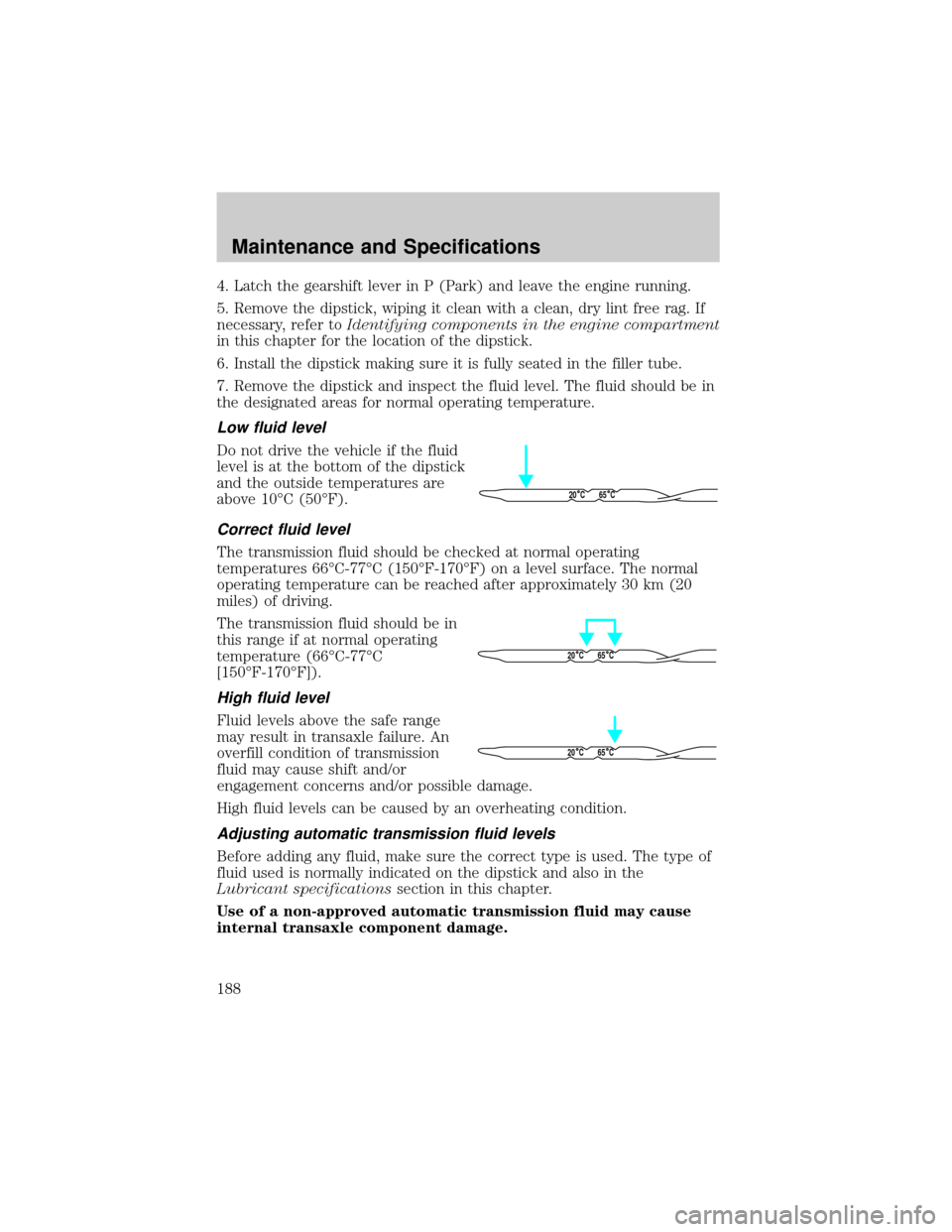2002 FORD ESCORT heating
[x] Cancel search: heatingPage 173 of 216

After any coolant has been added, check the coolant concentration see
Checking Engine Coolant section). If the concentration is not 50/50
(protection to ±34É F/±36É C), drain some coolant and adjust the
concentration. It may take several drains and additions to obtain a 50/50
coolant concentration.
Whenever coolant has been added, the coolant level in the coolant
reservoir should be checked the next few times you drive the vehicle. If
necessary, add enough 50/50 concentration of engine coolant and
distilled water to bring the liquid level to the proper level.
If you have to add more than 1.0 liter (1.0 quart) of engine coolant per
month, have your dealer check the engine cooling system. Your cooling
system may have a leak. Operating an engine with a low level of coolant
can result in engine overheating and possible engine damage.
Recycled engine coolant
Ford Motor Company recommends the use of a recycled engine coolant
produced by Ford-approved processes in vehicles originally equipped
with Motorcraft Premium Engine Coolant (green-colored). However, not
all coolant recycling processes produce coolant that meets Ford
specification ESE-M97B44±A. Use of such coolant may harm the engine
and cooling system components.
Ford Motor Company does NOT recommend the use of recycled engine
coolant in vehicles originally equipped with Motorcraft Premium Gold
Engine Coolant since a Ford-approved recycling process is not yet
available.
Used engine coolant should be disposed of in an appropriate
manner. Follow your community's regulations and standards for recycling
and disposing of automotive fluids.
Coolant refill capacity
To find out how much fluid your vehicle's cooling system can hold, refer
toRefill capacitiesin this chapter.
Fill your engine coolant reservoir as outlined inAdding engine coolant
in this chapter.
Maintenance and Specifications
173
Page 188 of 216

4. Latch the gearshift lever in P (Park) and leave the engine running.
5. Remove the dipstick, wiping it clean with a clean, dry lint free rag. If
necessary, refer toIdentifying components in the engine compartment
in this chapter for the location of the dipstick.
6. Install the dipstick making sure it is fully seated in the filler tube.
7. Remove the dipstick and inspect the fluid level. The fluid should be in
the designated areas for normal operating temperature.
Low fluid level
Do not drive the vehicle if the fluid
level is at the bottom of the dipstick
and the outside temperatures are
above 10ÉC (50ÉF).
Correct fluid level
The transmission fluid should be checked at normal operating
temperatures 66ÉC-77ÉC (150ÉF-170ÉF) on a level surface. The normal
operating temperature can be reached after approximately 30 km (20
miles) of driving.
The transmission fluid should be in
this range if at normal operating
temperature (66ÉC-77ÉC
[150ÉF-170ÉF]).
High fluid level
Fluid levels above the safe range
may result in transaxle failure. An
overfill condition of transmission
fluid may cause shift and/or
engagement concerns and/or possible damage.
High fluid levels can be caused by an overheating condition.
Adjusting automatic transmission fluid levels
Before adding any fluid, make sure the correct type is used. The type of
fluid used is normally indicated on the dipstick and also in the
Lubricant specificationssection in this chapter.
Use of a non-approved automatic transmission fluid may cause
internal transaxle component damage.
20 C65 C
20 C65 C
20 C65 C
Maintenance and Specifications
188
Page 205 of 216

A
Air bag supplemental
restraint system ..........................85
and child safety seats ..............87
description ................................85
disposal ......................................89
driver air bag ............................87
indicator light .....................12, 89
operation ...................................87
passenger air bag .....................87
Air cleaner filter ...............190, 195
Air conditioning
manual heating and air
conditioning system .................38
Antifreeze
(see Engine coolant) ................169
Anti-lock brake system
(see Brakes) ......................102±103
Anti-theft system ..................69±70
arming the system ....................70
disarming a triggered
system .................................70±71
disarming an untriggered
system .......................................70
warning light .............................14
Automatic transaxle .................105
driving with .............................106
fluid, adding ............................187
fluid, checking ........................187
fluid, refill capacities ..............195
fluid, specification ..................198
Axle
lubricant specifications ..........196
B
Battery .......................................167
acid, treating emergencies .....167charging system
warning light .............................12
jumping a disabled battery ....132
maintenance-free ....................167
replacement, specifications ...195
servicing ..................................167
Belt minder .................................81
Brakes ........................................102
anti-lock ...........................102±103
anti-lock brake system
(ABS) warning light .........12, 103
brake warning light ..................12
fluid, checking and adding ....186
fluid, refill capacities ..............195
fluid, specifications .........196, 198
lubricant specifications ..196, 198
parking ....................................104
shift interlock ..........................105
Break-in period .............................6
C
Capacities for refilling fluids ....195
Certification Label ....................200
Child safety restraints ................90
child safety belts ......................90
Child safety seats ........................91
attaching with tether straps ....95
in front seat ..............................92
in rear seat ................................92
Cleaning your vehicle
engine compartment ..............150
exterior ....................................154
instrument cluster lens ..........153
instrument panel ....................152
interior .....................................153
plastic parts ....................151±152
safety belts ..............................154
washing ....................................148
Index
205
Page 207 of 216

Fluid capacities .........................195
Foglamps .....................................42
Fuel ............................................175
calculating fuel economy .......180
cap .....................................13, 177
capacity ...................................195
choosing the right fuel ...........178
comparisons with EPA
fuel economy estimates .........183
detergent in fuel .....................179
filling your vehicle
with fuel ..................175, 177, 180
filter, specifications ........179, 195
fuel pump shut-off switch .....119
gauge .........................................16
improving fuel economy ........180
low fuel warning light ..............13
octane rating ...................178, 198
quality ......................................178
running out of fuel .................179
safety information relating
to automotive fuels ................175
Fuses ..................................121±122
G
Gas cap (see Fuel cap) ......13, 177
Gas mileage
(see Fuel economy) .................180
Gauges .........................................15
engine coolant temperature
gauge .........................................16
fuel gauge ..................................16
odometer ...................................17
speedometer .............................17
tachometer ................................17
trip odometer ............................17
GAWR (Gross Axle Weight
Rating) .......................................113
definition .................................113driving with a heavy load ......113
location ....................................113
GVWR (Gross Vehicle Weight
Rating) .......................................113
calculating ...............................113
definition .................................113
driving with a heavy load ......113
location ....................................113
H
Hazard flashers .........................119
Head restraints ...........................72
Headlamps ...................................42
aiming ..................................44±45
bulb specifications ....................48
daytime running lights .............42
flash to pass ..............................43
high beam ...........................14, 43
replacing bulbs .........................49
turning on and off ....................42
warning chime ..........................14
Heating
heater only system ...................37
heating and air conditioning
system .......................................38
Hood ..........................................160
I
Ignition .................................97, 198
Infant seats
(see Safety seats) .......................91
Inspection/maintenance
(I/M) testing ..............................184
Instrument panel ........................10
cleaning ...................................152
cluster ................................10, 153
lighting up panel
and interior ...............................43
Index
207